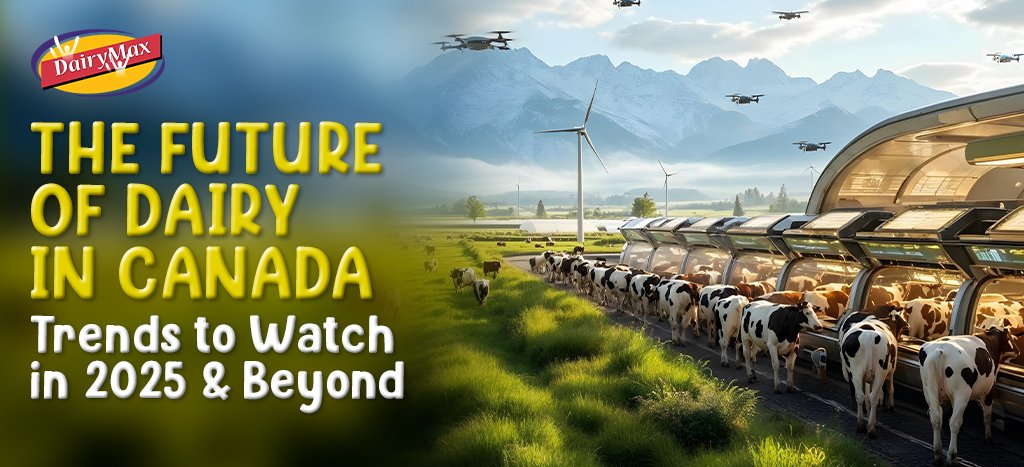The Canadian dairy industry, positioned at the threshold of a profound transformation as it moves toward 2025, seems set to rewrite the dairy supply story for marketers as well as consumers. Their opinions are changing; technology is evolving; regulations are also changing.
Sustainability and Environmental Responsibility
Environmental consciousness is increasingly influencing consumer choices. Over the past 15 years, the dairy sector has made notable strides, reducing greenhouse gas emissions by 17%, water usage by 10%, land utilization by 26%, and feed consumption by 15% (GREYB report).
In 2025 and beyond, dairy companies are expected to further prioritize sustainable practices, including efficient manure management and the adoption of renewable energy sources. Consumers are likely to favor brands that demonstrate a commitment to environmental stewardship.
Health and Wellness Trends
The shift from consuming normal foodstuff to health-conscious is a developing force changing the dairy market. There is a growing demand for products that contain functional benefits; for example, yogurt with probiotics and offerings like lactose-free and fat-reduced products. These demands are complemented by the innovation of dairy companies introducing new products toward the direction of these health and wellness trends in response to a burgeoning health-aware consumer.
Technological Advancements and Digitalization
Technology is bound to play a major role in the evolving dairy industry. From precision farming techniques to enhance production efficiency, to digital platforms for better supply chain management, technology is key to the dairy industry. Dairy supply companies will invest in innovations for greater product quality and traceability and in customer engagement to remain competitive in this fast-evolving marketplace.
Regulatory Changes and Trade Dynamics
Regulatory developments will continue to influence the dairy sector. Notably, the Canadian Dairy Commission has announced a slight reduction in farmgate milk prices for 2025, citing decreased feed costs and stabilized farm expenses (Farmtario, 2024).
Additionally, international trade agreements and disputes, such as New Zealand’s challenge regarding dairy access under the Comprehensive and Progressive Agreement for Trans-Pacific Partnership (CPTPP), may impact market dynamics. Stakeholders will need to stay informed and adaptable to navigate these regulatory landscapes effectively.
Consumer Preferences and Market Growth
Consumer preferences are shifting towards diversified and added-value dairy products. Starting from USD 16.2 billion in 2025, the Canadian dairy market is projected to grow to USD 21.3 billion by 2030, with a compound annual growth rate (CAGR) of 5.63%. This growth will be due to the desirability of cheese, yogurt, and specialty dairy items. Those suppliers of dairy near the consumers will have to innovate with their products to capture these changing tastes, which will also have to realize heightened expectations from a more discerning clientele.

Dairy Max: Leading the Way into the Future
As the industry evolves, Dairy Max remains at the forefront by embracing these emerging trends. With a steadfast commitment to sustainability, health-focused product development, and technological innovation, Dairy Max continues to provide high-quality dairy products that meet the changing needs of consumers. Explore Dairy Max’s diverse range of dairy products and experience the benefits of partnering with a forward-thinking dairy supply company. Visit Dairy Max to discover how their commitment to quality and innovation can enhance your dairy experience.
References
FAQ’s
1. What are the key trends shaping the future of dairy in Canada?
Key trends include sustainability, health-conscious product innovation, technological advancements in farming and production, and shifts in consumer preferences towards value-added dairy products.
2. How is the dairy industry addressing environmental concerns?
Dairy companies are adopting sustainable practices, such as reducing greenhouse gas emissions, efficient manure management, and utilizing renewable energy, to minimize their environmental impact.
3. What role does technology play in the future of dairy production?
Technology is revolutionizing dairy farming with precision techniques, improving product traceability, and streamlining supply chain management, ensuring better quality and efficiency in the industry.
4. How are consumer preferences influencing the dairy market?
Consumers are seeking functional, health-focused options, such as lactose-free, reduced-fat, and probiotic-rich products, driving dairy companies to innovate and diversify their offerings.
5. Why is Dairy Max considered a leader in the Canadian dairy industry?
Dairy Max stands out for its commitment to sustainability, high-quality products, and responsiveness to evolving market trends, making it a preferred choice among consumers and businesses alike.





